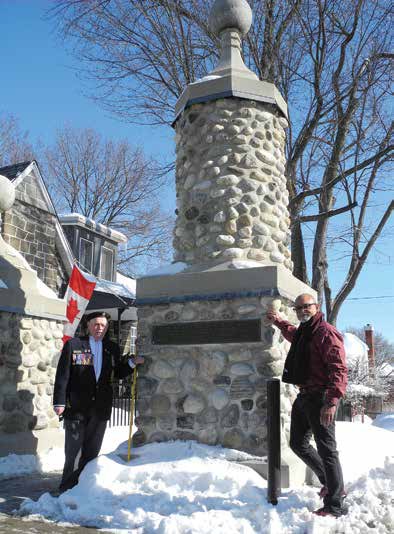John Dance
The Mainstreeter is publishing a draft article on the Brantwood Place Gates written for tentative inclusion in two Carleton University professors’ forthcoming book, entitled Monumental Memories: A Critical Reading of Memorials, Monuments, and Statues in Canada’s Capital Region. The article, based on the efforts of many Old Ottawa East residents, is a fascinating tale of perseverance to ensure the gates have remained a treasured heritage landmark. Footnotes have been removed to simplify the reading of this article.
It is often a gray day, with the occasional snowflake in the air. Many residents wait for the sounds of the marching band on Ottawa’s Main Street before grabbing their gloves and toques and rushing out to meet at the Brantwood Place Gates as part of an annual Remembrance Day ceremony. The ceremony lacks the Prime Minister and other dignitaries who gather two kilometres away at the National War Memorial, yet this local event is equally moving and just as important to those who attend.
The gates, the focal point of the ceremony, were built before the First World War. The Old Ottawa East monument has an intriguing history of creation, ongoing deterioration, periodic restoration, and, finally, reconstruction. The gates are still standing because of the efforts of generations of neighbours who have remained vigilant and assertive. Located on Main Street at Beckwith Road, the four fieldstone-covered pillars were built in 1912 as a “marketing ploy” to mark the entrance to Brantwood Place, “lending an air of exclusiveness and distinction to this high-class home section,” as a real estate pamphlet extolled.

Georges Winters of Branch 595, Royal Canadian Legion and Main Street resident Eugene Haslam are two advocates who have safeguarded the Brantwood Place Gates. Photo by John Dance
Without consultation, the City of Ottawa decided 35 years later that the gates were in a state of disrepair and impeded “snow removal efficiency.” A City crew appeared on July 2, 1947, and began their demolition work. The reaction of residents was immediate, forceful and effective. In just one day, a petition protesting the demolition was signed by 285 “heads of homes” and presented to the local alderman. Over two days, the Evening Citizen ran four items on the residents’ outrage, including a photo documenting “the pillage of the pillars.” [Editor’s Note: Read excerpts from the 1947 Evening Citizen on Over my dead body! 1947: Tear down the Brantwood Place Gates, will ‘ya? page.] In response, the City reversed its decision, and the gates were saved.
Over the next two years, residents convinced the City to dedicate the gates as a war memorial. This ensured that the landmark, a key part of the community’s identity, would be conserved under the aegis of civic remembrance. Door-to-door canvassing raised funds for a brass memorial plaque. “To the memory of those who made the supreme sacrifice and to the honour and glory of those men and women of this community who served in the armed forces,” the plaque read. “Praise can add nothing to their gallant worth.” The community’s effort to repurpose the gates as a war monument had an enduring impact: war monuments tend not to be torn down, particularly when they are a valued landmark in their communities.
But all monuments can fall into disrepair. The Brantwood Place Gates face a roadway that, by the 1970s, had changed from two lanes of slow traffic to one of Ottawa’s major four-lane arterials. Main Street’s expansion, the vibrations of passing vehicles, and corrosive
road salt led to their steady deterioration. Residents regularly complained about the state of the gates, concerns which the City periodically addressed.
By 1977, the war memorial plaque had tumbled off into the gutter, only to be retrieved by one of the leaders of the original save the gates effort. Residents now pushed for restoration. Two years later the gates were declared a heritage asset by the City and, in 1982, after $5,000 of repairs, the Royal Canadian Legion, Strathcona Branch 595 led an event to rededicate the gates. New plaques in French and English and one designating the gates a heritage structure were added.
The next two decades saw the further deterioration of the gates. Prompted by a concerned citizenry, the City prepared “deficiency reports,” which proposed long-term solutions, including the idea of reconstructing the gates in nearby Brantwood Park. But residents did not want the gates moved off Main Street. In 2010 the City commissioned a thorough analysis of the gates that, again, resulted in recommendations to fully reconstruct the gates. With the strong support of the community and a City investment of almost half a million dollars, the gates were finally reconstructed as part of the transformation of Main Street into Ottawa’s first major “complete street.”
As a result of enduring and effective community activism, the Brantwood Place Gates remains a local landmark that preserves and honours the memory of those who served in the two world wars.
Acknowledgments: While no individuals except developer Robert Sibbitt are mentioned in the draft article, some of the key contributors over the years are: E.P. Nunn and Art Humphries, who were instrumental in saving the gates from demolition and having them designated as a war memorial in 1949; Robert Kelly, who lobbied for heritage designation for the gates in 1979; Pierre Johnson, Susan MacPhee, Nancy Smith, Rick Wallace and Heather Moxsley, who led the restoration campaign in 2003; and Main Street resident Eugene Haslam and Branch 595’s Georges Winters, both of whom fought for the full restoration of the gates more recently.
![]() If you see any errors or omissions in the draft article, please inform The Mainstreeter or John Dance. The book – Monumental Memories – authored by professors Tonya Davidson & David Dean will be published by McGill-Queen’s University Press.
If you see any errors or omissions in the draft article, please inform The Mainstreeter or John Dance. The book – Monumental Memories – authored by professors Tonya Davidson & David Dean will be published by McGill-Queen’s University Press.






